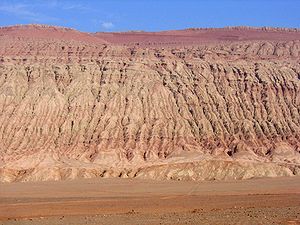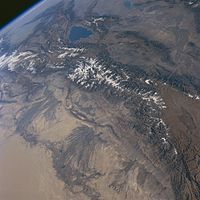| Revision as of 13:10, 18 October 2014 editDoc James (talk | contribs)Administrators312,294 edits Reverted to revision 611722147 by 82.35.125.237 (talk): Ref needed. (TW)← Previous edit | Revision as of 00:09, 20 October 2014 edit undoBenfxmth (talk | contribs)Extended confirmed users1,147 edits Undid revision 630101074 by Jmh649 (talk)Next edit → | ||
| Line 70: | Line 70: | ||
| |accessdate=2007-09-21 | |accessdate=2007-09-21 | ||
| }}</ref> | }}</ref> | ||
| ==Climate== | |||
| The climate is harsh, and the extremely high summer temperatures make this the hottest spot in China, frequently reaching 50 °C (122 °F) or higher. One of the largest thermometers in China. The Flaming Mountains, located in the Tian Shan Mountain range of Xinjiang, China, likely were named for striking gullies that have been eroded into the red sandstone bedrock, resembling a flame. But the name is also apt for another reason: These mountains are sizzling hot. Though there is not a weather station located here to measure temperature directly, a NASA satellite equipped with a moderate resolution imaging spectroradiometer, or MODIS — a device capable of measuring land surface temperatures from space — recorded one of the highest temperatures ever measured: 152.2 degrees. The reading, recorded in 2008, was the hottest measurement on Earth that year. | |||
| {{Weather box | |||
| |location = Flaming Mountains | |||
| |imperial first = yes | |||
| |single line = yes | |||
| |Jan record high F = 77 | |||
| |Feb record high F = 97 | |||
| |Mar record high F = 108 | |||
| |Apr record high F = 130 | |||
| |May record high F = 137 | |||
| |Jun record high F = 144 | |||
| |Jul record high F = 149 | |||
| |Aug record high F = 144 | |||
| |Sep record high F = 139 | |||
| |Oct record high F = 122 | |||
| |Nov record high F = 103 | |||
| |Dec record high F = 75 | |||
| |Jan record low F = -11 | |||
| |Feb record low F = -23 | |||
| |Mar record low F = -8 | |||
| |Apr record low F = 46 | |||
| |May record low F = 55 | |||
| |Jun record low F = 61 | |||
| |Jul record low F = 80 | |||
| |Aug record low F = 78 | |||
| |Sep record low F = 66 | |||
| |Oct record low F = 53 | |||
| |Nov record low F = 28 | |||
| |Dec record low F = 13 | |||
| |source 1 = <ref name = "ncdc"> {{cite web |url = http://http://www.ncdc.noaa.gov/cdo-web/datasets/GHCNDMS/stations/GHCND:CHM00051573/detail |title = Monthly Summaries Station Details: TURPAN, CH, GHCND:CHM00051573 |Climate Data Online (CDO) | National Climatic Data Center (NCDC) | accessdate = | publisher = Benfxmth</ref> | |||
| |date=October 2014 | |||
| }} | |||
| ==Footnotes== | ==Footnotes== | ||
Revision as of 00:09, 20 October 2014

The Flaming Mountains (Chinese: 火焰山; pinyin: huǒyànshān) or Gaochang Mountains are barren, eroded, red sandstone hills in Tian Shan Mountain range, Xinjiang, China. They lie near the northern rim of the Taklamakan Desert and east of the city of Turpan. Their striking gullies and trenches caused by erosion of the red sandstone bedrock give the mountains a flaming appearance at certain times of the day.
The mountains are approximately 100 kilometres (60 mi) long and 5–10 km (3–6 mi) wide, crossing the Turpan Depression from east to west. The average height of the Flaming Mountains is 500 m (1,600 ft), with some peaks reaching over 800 m (2,600 ft). The mountain climate is harsh, and the extremely high summer temperatures make this the hottest spot in China, frequently reaching 50 °C (122 °F) or higher. One of the largest thermometers in China—a popular tourist spot—is on display adjacent to the mountain, tracking the surrounding air temperature.
A number of important palaeontological remains have been found in the area. (See e.g. Lianmuqin Formation, Subashi Formation).
Silk route


In ancient times, the merchant traders traversing the Silk Route in southeast Asia avoided the mountains by stopping at oasis towns, such as Gaochang, build on the desert's rim at the foot of the Flaming Mountains and near an important mountain pass. Oasis towns became respite stops for traveling merchant traders. Buddhist missionaries often accompanied traders on busy international trade routes. During this time trade boomed on the Silk Route. Buddhist monasteries and temples were built in the busy trading centers and in nearby remote mountain spots.
The Bezeklik Thousand Buddha Caves site lies in a gorge under the cliffs of the Flaming Mountains near the pass by Gaochang. It is a complex of seventy Buddhist cave grottoes dating from the 5th to the 9th centuries CE, many with thousands of murals of Buddha.
Literary fame
The Flaming Mountains received their name from a fantasy account of a Buddhist monk, accompanied by a Monkey King with magical powers. The monk runs into a wall of flames on his pilgrimage to India in the popular 16th century novel, Journey to the West, by Ming Dynasty writer, Wu Cheng'en. The novel is an embellished description of the monk Xuanzang who traveled to India in 627 CE to obtain Buddhist scriptures and went through a pass in the Tien Shan after leaving Gaochang.
Mythology
According to the classical novel Journey to the West, the Monkey King created a disturbance in the heavens and knocked over a kiln, causing embers to fall from the sky to the place where the Flaming Mountains are now. In a Uigur legend, a dragon lived in the Tianshan Mountains. Because the dragon ate little children, a Uigur hero slew the dragon and cut it into eight pieces. The dragon's blood turned into a scarlet mountain of blood and the eight pieces became the eight valleys in the Flaming Mountains.
Climate
The climate is harsh, and the extremely high summer temperatures make this the hottest spot in China, frequently reaching 50 °C (122 °F) or higher. One of the largest thermometers in China. The Flaming Mountains, located in the Tian Shan Mountain range of Xinjiang, China, likely were named for striking gullies that have been eroded into the red sandstone bedrock, resembling a flame. But the name is also apt for another reason: These mountains are sizzling hot. Though there is not a weather station located here to measure temperature directly, a NASA satellite equipped with a moderate resolution imaging spectroradiometer, or MODIS — a device capable of measuring land surface temperatures from space — recorded one of the highest temperatures ever measured: 152.2 degrees. The reading, recorded in 2008, was the hottest measurement on Earth that year.
| Climate data for Flaming Mountains | |||||||||||||
|---|---|---|---|---|---|---|---|---|---|---|---|---|---|
| Month | Jan | Feb | Mar | Apr | May | Jun | Jul | Aug | Sep | Oct | Nov | Dec | Year |
| Record high °F (°C) | 77 (25) |
97 (36) |
108 (42) |
130 (54) |
137 (58) |
144 (62) |
149 (65) |
144 (62) |
139 (59) |
122 (50) |
103 (39) |
75 (24) |
149 (65) |
| Record low °F (°C) | −11 (−24) |
−23 (−31) |
−8 (−22) |
46 (8) |
55 (13) |
61 (16) |
80 (27) |
78 (26) |
66 (19) |
53 (12) |
28 (−2) |
13 (−11) |
−23 (−31) |
| Source: | |||||||||||||
Footnotes
- Keay, John (2000). India: A History. New York: Grove Press. pp. pp. 103, 124–27. ISBN 0-8021-3797-0.
{{cite book}}:|pages=has extra text (help) - ^ Ebrey, Patricia (2006). The Cambridge Illustrated History of China. Cambridge University Press. pp. pp. 106–7, 202. ISBN 0-521-43519-6.
{{cite book}}:|pages=has extra text (help) Cite error: The named reference "cambridge" was defined multiple times with different content (see the help page). - "Bizaklik Thousand Buddha Caves". showcaves.com. Retrieved 2007-09-19.
- "Bizaklik Thousand Buddha Caves". travelchinaguide. Retrieved 2007-09-19.
- "The Third Cross-Strait Conference — Post-conference Tour to the Flaming Mountains". University of Massachusetts.edu. Retrieved 2007-09-18.
- "The Flaming Mountains (Huo Yan Shan)". travelchinaguide.com. Retrieved 2007-09-21.
{{cite web}}: Cite has empty unknown parameter:|month=(help) - {{cite web |url = http://http://www.ncdc.noaa.gov/cdo-web/datasets/GHCNDMS/stations/GHCND:CHM00051573/detail |title = Monthly Summaries Station Details: TURPAN, CH, GHCND:CHM00051573 |Climate Data Online (CDO) | National Climatic Data Center (NCDC) | accessdate = | publisher = Benfxmth
External links
- Photo of the Flaming Mountains
- Xinjiang
- Gaochang
- Xinjiang is home to 47 ethnic groups
- Xinjiang Guide
- The Bezeklik Grottoes in the Flaming Mountains near Turpan - Photo
42°53′N 89°38′E / 42.883°N 89.633°E / 42.883; 89.633
| Xinjiang topics | |||||||||||||||
|---|---|---|---|---|---|---|---|---|---|---|---|---|---|---|---|
| Ürümqi (capital) | |||||||||||||||
| History |
| ||||||||||||||
| Geography |
| ||||||||||||||
| Education Research | |||||||||||||||
| Culture | |||||||||||||||
| Cuisine | |||||||||||||||
| Economy | |||||||||||||||
| Visitor attractions | |||||||||||||||
| Related |
| ||||||||||||||